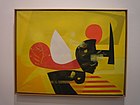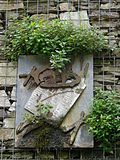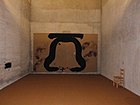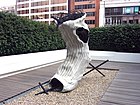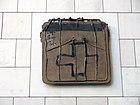Antoni Tàpies
Antoni Tàpies | |
|---|---|
 Tàpies in 2002 | |
| Born | 13 December 1923 Barcelona,Spain |
| Died | 6 February 2012(aged 88) Barcelona, Spain |
| Known for | Painting,sculpture,lithography |
| Movement | Art informel |
| Awards | Praemium Imperiale |
Antoni Tàpies i Puig, 1stMarquess of Tàpies(Catalan:[ənˈtɔniˈtapi.əs];13 December 1923 – 6 February 2012) was aSpanishpainter, sculptor and art theorist.[1]


Life[edit]
The son of Josep Tàpies i Mestre and Maria Puig i Guerra, Antoni Tàpies Puig was born in Barcelona on 13 December 1923. His father was alawyerandCatalan nationalistwho served briefly with theRepublican government.Due to this, Tàpies grew up in an environment where he was exposed to a variety of cultural and social experiences of leaders in the Catalan public life and its republicanism. His maternal grandmother also exposed him to this world with her great involvement in civil and political activities.
Tàpies was first introduced tomodern artas he enteredsecondary schoolin 1934. He became inspired by famous Christmas issue of the magazine,D’ací i d’allà,which contained reproductions of works by artists such asMarcel Duchamp,Georges Braque,Wassily KandinskyandPablo Picasso.[2]At 17, Tàpies suffered a near-fatalheart attackcaused bytuberculosis.He spent two years as a convalescent in the mountains, reading widely and pursuing an interest in art that had already expressed itself when he was in his early teens.[3]
Tàpies studied at theGerman School of Barcelona.After studying law for three years, he devoted himself from 1943 onwards only to his painting. In 1945 Tàpies began experimenting with materials. At this time he also became increasingly interested inphilosophy,especially that ofJean-Paul Sartreas well asEastern thought.[4] He became known as one of Spain's most renowned artists in the second half of the 20th century.[5]Hisabstract artand other avant-garde works were displayed in many major museums all over the world.[6]In 1954, Tàpies married Teresa Barba Fabregas. Together, they had three children Antoni, Miguel and Clara.[7] He lived mainly inBarcelona.
Tàpies died on 6 February 2012.[6]
Work[edit]
Tàpies first came into contact with contemporary art as a teenager through the magazineD’Ací i D’Allà,published in Barcelona, and during the Spanish Civil War (1936–39), while he was still at school, he taught himself to draw and paint.[8]On a French government scholarship in the early 1950s, he lived inParis,to which he often returned. Both in Europe and beyond, the highly influential French critic and curatorMichel Tapiéenthusiastically promoted the work of Antoni Tàpies.
In 1948, Tàpies helped co-found the first post-war movement in Spain known asDau al Setwhich was connected to theSurrealistandDadaistMovements. The main leader and founder ofDau al Setwas the poetJoan Brossa.The movement also had a publication of the same name,Dau al Set.Tàpies started as asurrealistpainter, his early works were influenced byPaul KleeandJoan Miró;[9]but soon become aninformalartist, working in a style known aspintura matèrica,in which non artistic materials are incorporated into the paintings. In 1953, he began working inmixed media;which is considered his most original contribution to art. One of the first to create serious art in this way, he added clay and marble dust to his paint and used waste paper, string, and rags (Grey and Green Painting, Tate Gallery, London, 1957).Canvas Burned to Matterfrom c. 1960, in the collection of theHonolulu Museum of Art,is an example of the artist'smixed mediaassemblagesthat combine the principles ofDadaandSurrealism.[10]

Tàpies' international reputation was well established by the end of the 1950s. From the late 1950s to early 1960s, Tàpies worked withEnrique Tábara,Antonio Saura,Manolo Millaresand many other Spanish Informalist artists. In 1966, he was arrested at a clandestine assembly at theUniversity of Barcelona;his work of the early 1970s is marked by symbols ofCatalanidentity (which was anathema toFranco).[11]In 1974 he made a series of lithographs calledAssassinsand displayed them in theGalerie Maeghtin Paris, in honour of militantanarchistSalvador Puig Antich's memory. In about 1970 (influenced bypop art), he began incorporating more substantial objects into his paintings, such as parts of furniture. Tàpies's ideas have had worldwide influence on art, especially in the realms of painting, sculpture, etchings and lithography. Examples of his work are found in numerous major international collections. His work is associated with bothTachismeandAbstract Expressionism.
The paintings produced by Tàpies, later in the 1970s and in the 1980s, reveal his application of this aesthetic of meditative emptiness, for example in spray-painted canvases with linear elements suggestive of Oriental calligraphy, in mixed-media paintings that extended the vocabulary of Art informel, and in his oblique allusions to imagery within a fundamentally abstract idiom, as inImprint of a Basket on Cloth(1980).[8]Among the artists' work linked in style to that of Tàpies is that of the American painterJulian Schnabelas both have been connected to the art term "Matter".[12]
Graphic work[edit]
Tàpies began producinggraphic workin 1947. He produced collector’s books and dossiers in association with poets and writers such asAlberti,Bonnefoy,Du Bouchet,Brodsky,Brossa,Daive,Dupin,Foix,Frémon,Gimferrer,Guillén,Jabès,Mestres Quadreny,Mitscherlich,Paz,Saramago,Takiguchi,Ullán,ValenteandZambrano.[13]
Essays[edit]
Tàpies has written essays which have been collected in a series of publications, some translated into different languages:La pràctica de l’art(1970),L’art contra l’estètica,(1974),Memòria personal(1978),La realitat com a art(1982),Per un art modern i progressista(1985),Valor de l’art (1993)andL’art i els seus llocs(1999).[14]These works include Tàpies reflecting on things such as art, life, and politics. He also discusses the social role of art and the artist, reflects on the influences of his work, and explains his artistic as well as political views.[15]
Movements[edit]
Throughout the span of his life, Antoni Tàpies has been associated with a number of movements such asArt InformelandHaute Pâte,both of which were popular in post-war Europe.[16]He became a part of theavant-gardegroup Dau al Set in 1948, a group that had strong ties to Surrealism. Early works of his were surrealistic, but in 1953 he began working in abstract art. Some of Tàpies's most famous and original works fall within this genre. They are characterized by his use of marble dust and clay that he mixed with his paints as well as the incorporation of found objects such as string, paper, and cloth. In the late 1960s into the early 1970s Tàpies began to be influenced by the movement ofpop art.Because of this he began using larger items, such as pieces of furniture, in his works.[17]
Exhibitions[edit]
- In 1950, Tàpies' first solo show was held at the Galeries Laietanes, Barcelona, and he was included in theCarnegie InternationalinPittsburgh.[18]
- In 1953 he had his first shows in theUnited States,at the Marshall Field Art Gallery inChicagoand theMartha Jackson Galleryin New York.[3]
- In 1962 he was given the opportunity to have a Guggenheim Retrospective.[19]
- Some of his other retrospectives were presented at theMusée National d'Art Moderne,Paris, in 1973 and at theAlbright-Knox Art Gallery,Buffalo, New York, in 1977.[18]
- Later he was the subject of retrospective exhibitions at theJeu de Paumein Paris in 1994.
- Kestnergesellschaftin Hannover in 1998.
- In the year 2000 in New York, he had an exhibition at thePace Gallery,which consisted of multimedia paintings as well as small bronzes and assemblages.[20]
- TheMuseo Nacional Centro de Arte Reina SofíainMadridin 2000, and was exhibited at theAnita Shapolsky Galleryin New York City in 2006, 2012, and 2014.[21][22]
- In 2007 at the age of 83, Tàpies had an exhibition at Pace Wildenstein where he showed 17 paintings done on wood as well as canvas.[19]
- In 2017,Nahmad Contemporaryin New York presented the exhibitionTàpies: Paintings, 1970–2003.
- 'Antoni Tàpies. Objects'. Until February, 2018 at Fundació Antoni Tàpies museum, Barcelona
Legacy[edit]
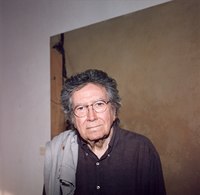

TheFundació Antoni Tàpiesis a museum and cultural center located inCarrer d'Aragó,inBarcelonathat is dedicated to the works and life of Antoni Tàpies. It was established in 1984 by Tàpies himself. His intent was to create a forum that would promote the study as well as the knowledge of modern and contemporary art. It includes the temporary exhibitions, film seasons, lectures, symposiums, as well as different activities and showings of Tàpies's work. The foundation owns one of the most extensive collections of Tàpies's work, mostly donated by Tàpies himself. It also contains a large library that is dedicated solely to the artists of our century and the modern literature and documentation pertaining to the genre.[23]
Recognition[edit]
- Tàpies was awarded in 1958 the First Prize for painting at the Pittsburgh International, and theUNESCOand David E. Bright Prizes at theVenice Biennale.[24]
- In 1958 Tàpies, along withEduardo Chillida,represented Spain in theVenice Biennale.[7]
- He received the Rubens Prize ofSiegen, Germany,in 1972.[18]
- In the Academic Sphere, he received an Honorary Doctorate from theRovira i Virgili Universityin 1994.
- In 2003 Tàpies won Spain's most prestigious art award, the Velázquez prize.[25]
- On 9 April 2010, he was raised into theSpanish nobilitybyKing Juan Carlos Iwith the hereditary title ofMarqués de Tápies(Marquess of Tàpies)[26](English: Marquess of Tàpies).
- Furthermore, he designedRovira i Virgili University’slogo, which is characterized by the letter "a", symbol of the university's knowledge principle.
Gallery of works[edit]
-
Tàpies, 1952,Els Solcs,oil-painting
-
Tàpies, 1971,Escut font de la Budellera,sculpture / relief
-
Tàpies, 1971,Pantalons sobre vestidor / Trousers on stretchers,textile on the backside of a stretched canvas
-
Tàpies, 1982–83,Homage to Picasso / Homenatge a Picasso,installation
-
Tàpies, 1990,Núvol i Cadira / Cloud and Chair,tube-sculpture above the facade of theFundació Antoni Tàpies
-
Tàpies, 1991,Conté el Díptic de la campana- part of project 'Sala de Reflexió'
-
Tàpies, 1991,Mitjó,sculpture
-
Tàpies, 1993,Rinzen,installation
-
Tàpies, undated,Creu 31
See also[edit]
Notes[edit]
- ^Oxford Dictionary of Modern and Contemporary Art, Oxford University, pp. 700-701
- ^"1923-1943".Fundació Antoni Tàpies.Archived fromthe originalon 24 September 2015.Retrieved1 April2015.
- ^abGrimes, William (6 February 2012)."Antoni Tàpies, Spanish Abstract Painter, Dies at 88".The New York Times.
- ^"1944-1948".Fundació Antoni Tàpies.Archived fromthe originalon 24 September 2015.Retrieved1 April2015.
- ^Oxford Dictionary of Modern and Contemporary Art, Oxford University, p. 700
- ^ab"Obituaries; Passings; Antoni Tapies; Prominent Spanish art figure". Tribune Publishing Company LLC.
- ^abGrimes, William (8 February 2012)."Antoni Tapies, a Painter With Textures, Dies at 88".The New York Times.p. B17.ProQuest920207376.
- ^abAntoni TàpiesMoMA Collection, New York.
- ^Oxford Dictionary of Modern and Contemporary Art, Oxford University, p. 701
- ^Honolulu Museum of Art, wall label,Canvas Burned to Matter,accession 4418.1
- ^Martin Gayford (25 March 2006),From earth to eternityThe Daily Telegraph.
- ^"Matter painting".tate.org.uk.
- ^"Antoni Tàpies".Fundació Antoni Tàpies.Archived fromthe originalon 17 October 2013.Retrieved1 April2015.
- ^Antoni TàpiesArchived17 October 2013 at theWayback MachineFundaciò Tàpies, Barcelona.
- ^"Antoni Tàpies - Volume II Collected Essays".Indiana University Press.Retrieved10 April2015.
- ^"Antoni Tapies." - WikiArt.org. N.p., n.d. Web. 17 Apr. 2015.
- ^"Antoni Tapies (1923-2012)." Antoni Tapies: Spanish Abstract Painter: Biography, Matter Paintings. N.p., n.d. Web. 17 Apr. 2015.
- ^abcAntoni Tàpies[permanent dead link]Guggenheim Collection.
- ^abKatz, V. (2007). Antoni Tàpies at PaceWildenstein. Art In America, 95(1), 138.
- ^Johnson, Ken (4 February 2000)."ART IN REVIEW; Antoni Tapies".The New York Times.ProQuest431373612.
- ^"Antoni Tàpies 1923-2012, ES".ArtFacts.net.
- ^"Art: The Expressive Edge of Paper",Highbrow Magazine,February 24, 2014
- ^"Antoni Tàpies foundation".Barcelona.Retrieved10 April2015.
- ^Antoni TàpiesTate Collection.
- ^"Barcelona Remembers Antoni Tàpies and His Iconic Catalan Creations." OhBarcelona. N.p., n.d. Web. 17 Apr. 2015.
- ^Real Decreto 433/2010– Website BOE
References[edit]
- Antoni Tàpies andMichel Tapié.Antonio Tapies[sic], New York, G. Wittenborn, 1959.OCLC1090149
- Solomon R. Guggenheim Museum.Antoni TàpiesNew York [©1962]OCLC2272922
- Mor Antoni Tàpies
- La premsa internacional destaca la mort "d'un dels grans artistes europeus"
- Antoni Tàpies art in Barcelona
External links[edit]
- 1923 births
- 2012 deaths
- Abstract painters
- Art Informel and Tachisme painters
- Painters from Catalonia
- Sculptors from Catalonia
- 20th-century Spanish painters
- 20th-century Spanish male artists
- Spanish male painters
- 21st-century Spanish painters
- Spanish male sculptors
- Dau al Set
- Spanish modern painters
- Painters from Barcelona
- Wolf Prize in Arts laureates
- Recipients of the Praemium Imperiale
- Marquesses of Spain
- 20th-century sculptors
- Spanish contemporary artists
- Honorary Members of the Royal Academy
- 21st-century Spanish male artists

